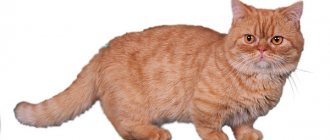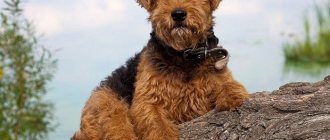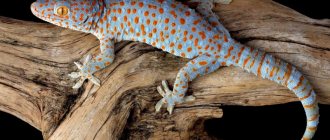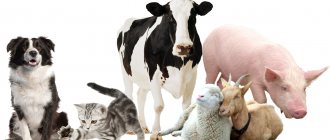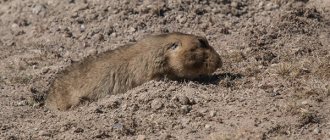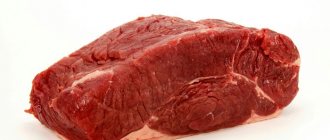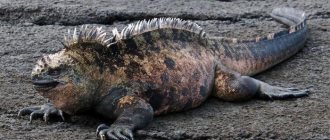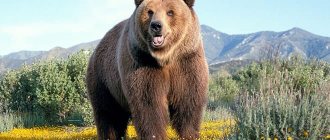Breed characteristics
| Short description | |
| Origin: | Ireland |
| Conditions of detention: | Apartment, country housing |
| Purpose: | Companion |
| Color: | Wheat (from light golden to deep red) |
| Wool length: | Medium length, up to 12.7 cm (except puppies) |
| Adult dog size: | The height of males is from 46 to 48 cm at the withers, weight is from 18 to 20.5 kg. Females are somewhat lower and lighter; the standard does not provide specific parameters. |
| Average life expectancy: | 12-16 years old |
| Walk: | 2 times a day, for a long time |
| Physical activity needs: | Moderate level |
| Fédération Cynologique Internationale (FIC) classification: | Group No. 3 Terriers Section No. 1 Large and medium terriers |
| Puppy price: | 25,000-50,000 rub. Pet class – 25-29,000 rubles. Breeding class – 30-35,000 rubles. Show class – 36-50,000 rubles. |
Making up a diet
The diet of wheaten terriers has its own characteristics. So, they do not need a significant amount of protein food; they can be given more cereals, vegetables, and fruits. You should not give your pet fatty, smoked, salty, spicy foods, sweets and freshly baked bread, beans and grapes. But in general, it is believed that the ideal option for such a dog is ready-made high-quality food, both dry and canned.
Choose the most suitable food for your dog: Pedigree, Grandorf, FortiFlora.
Puppies begin feeding solid food at three weeks of age. First, the food is diluted with warm water until it becomes mushy. Dry food should not be diluted with cow's milk; this often leads to stomach upset. Up to 4 months, puppies are fed 5 times a day, then the feeding frequency is gradually reduced to 2-3 times a day.
History of the origin of the species
The history of the development of the breed goes back more than 2 centuries, but it is impossible to establish for certain when and from whom the first representatives of the species originated, and which dogs were used for selection. This is due to the fact that breeding was carried out by Irish farmers, who paid less attention to external characteristics, but to working qualities.
Animals were needed to exterminate rodents, hunt otters and badgers, and also help owners in grazing livestock. Until recently, mandatory testing of the working characteristics of dogs was carried out during its breed assessment.
The first documented mention of wheaten terriers dates back to the 17th century, where they were described as “soft-haired” dogs. Animals are almost not represented in the history of literature, because... were considered pets for the lower class, not worthy of the attention of the nobility.
The breed, formerly called the Highend, is believed to be related to the Irish Wolfhound and local terrier varieties, although this has not been scientifically proven. Natural selection led to the appearance of dogs of very different conformations, and although at the end of the 19th century. animals of this species began to participate in exhibitions; they did not have common external features. In addition, up to the 20th century. Irish terriers were not divided into separate breeds.
During the First World War, dogs were used as signalmen and also to help the wounded. The number of livestock decreased slightly after this event, as well as the separation of the more popular Irish breed. However, through the efforts of enthusiasts, wheaten terriers were resurrected.
The breed was officially recognized by the Irish Kennel Club in 1937 and received its own name. After 2 decades, it was registered by the IFF, after which it began to spread throughout the world. In Russia, the first representatives of the “wheat farmers” appeared in the early 2000s.
What nicknames are best for soft-haired Irish terriers?
Typically, puppies from six weeks of age already have nicknames written down in their pedigree. But this does not mean that you cannot come up with a nickname for your pet that will be used daily.
By the way, this breed appeared in such works as “The Wizard of Oz” and in the story about Scarlett O’Hara; it is quite possible to name a dog after one of the characters in these literary works.
But it is best to give animals names that best suit their appearance or character. For example: Aurora, Bestia, Marquise, Goldilocks, Hurricane, Pudding, Joker, Gangster, Dragon. Irish place names can be used: Dublin, Belfast, Killarney, Ennis. Or use a shortened pedigree nickname.
Distinctive features
Dogs of this type must meet the requirements of the FCI standard, which provides the following parameters:
- The head has a flat skull of moderate width, not coarse. The stop is clearly visible. The muzzle is approximately equal in length to the skull. Cheekbones are poorly developed.
- The bite is scissors, although a straight bite is acceptable. The jaws are strong with large teeth.
- The nose is large and always black.
- The eyes are a rich dark brown shade. They are of medium size, not flat, but not convex either.
- The neck is strong, of normal length, and not “damp”.
- The ears are small in size, go up, and at the level of the skull line they bend down and straight. They should not “fly” when moving, they should lie tightly.
- The tail can be natural or docked to a third of its length. Usually raised, but not carried over the back.
- The body is approximately square in shape, with a strong and straight back, and a shortened lumbar area. The sternum is voluminous, with rounded ribs.
- The legs are straight, with developed bones and muscles. The angles of the knee joints and scapula are well defined. The hocks are not turned out and not high. The paws are small with dark claws.
- The coat of adult animals is soft, but not fluffy like that of a poodle, of medium length, covering the muzzle. It has a characteristic large curl or wave, and is devoid of undercoat (except for the inner area of the auricle). It is acceptable to exhibit dogs after trimming or in their natural state.
In the first case, the natural length of the fur is left above the eyes, in the area of the mustache and beard, on the limbs, and lightly removed along the body, emphasizing the silhouette. The neck, chest, skull and tail are cut short. The color allows all shades of wheat, the inside of the ear can be darker. The texture, length and color of the coat are finally formed at 18-24 months.
Photo of an adult dog
Photos of puppies
Features of character and behavior
The Irish Wheaten is an active, hardy and very affectionate animal. He is not aggressive and is devoted to his owner and his family.
Advantages
- It is worth noting the animal’s orientation towards the owner and his loved ones. The dog always strives to get approval, to be close, to play and to accompany the owner in all endeavors.
- The terrier gets along with children, obeys their commands, and does not show aggression.
- The energetic nature of dogs makes them wonderful companions for kids when playing pranks.
- In general, we can say that representatives of the breed are focused on communicating with people in principle. They have a positive attitude towards guests and passers-by, they love to be petted and communicated.
- “Wheaties” have a hard time withstanding loneliness, so they will not appreciate being kept in an enclosure.
- For all their energy, they are one of the calmest terriers.
- They are unobtrusive, do not fight with their brothers without reason, and can get along with other animals. In addition, the Irish are smart, quickly learn “etiquette” and behave well at home and on walks.
Flaws
- Despite the sympathy for children, it is not recommended to have such a pet if the baby is too young. An active and cheerful animal can accidentally hit or knock over a child.
- In addition, all dogs of this species jump high and love to do this, especially when meeting members of the owner’s family or friends. As a result, they can stain a person, scratch them or knock them over. Therefore, it is worth weaning the Irish from this habit from a young age.
- Dogs of this breed need active walking, so you should not deprive them of an outburst of energy. Otherwise, they may make a mess in the house or bark loudly. They also like to dig up flower beds, which is unlikely to please the neighbors.
- Given the tendency to create tunnels and jumps, you will have to secure the site of a country house with a high fence, with pillars and sections going underground.
- Like all terriers, the Irish have hunting instincts, so they can run after the “prey” during a walk or attack a small pet.
- They will also always fearlessly react to attacks from other dogs, especially those of their own gender. The stubbornness characteristic of terriers is present in them, but not so pronounced.
Theses
- IMPT can live in an apartment, private house, city or village.
- If you are obsessed with order, then these dogs may not be for you, as they love to run, jump, collect dirt and carry it into the house.
- They are not aggressive towards other dogs, but they do chase small animals.
- Wheaten Terriers do not tolerate heat well; in summer they need to be kept in an air-conditioned house.
- Terriers love to dig and the Soft Coated is no exception. Be prepared for trenches in your yard.
- They love the company of people and become stressed from loneliness.
- They love children and get along well with them.
- Independent and willful, training requires experience and knowledge.
- The Wheaten Terrier's coat sheds imperceptibly, but requires daily grooming.
Care and maintenance
A fairly long cover creates some difficulties in care. However, such wool allows you not to freeze in winter and avoid warm clothes while walking.
- The structure of the ears requires attention, especially during the summer and peak tick activity. They need to be inspected daily, because... Accumulating earwax and sweat in the absence of ventilation often cause inflammation.
- The eyes are less likely to cause problems, so it is enough to monitor them once a week and, if necessary, wipe them from dirt.
- Every month you need to pay attention to the claws , trimming the overgrown tips.
The breed is predisposed to certain diseases, so periodic monitoring by a veterinarian and nutritional monitoring are required.
Nutrition
Representatives of the breed are not prone to excess weight, but are prone to allergies and reactions to protein. “Wheaties” can be fed with both natural food and professional products.
Regardless of what your pet eats, you should pay attention to hypoallergenic ingredients and avoid eggs, chicken, cereals, bread and potatoes.
All new products should be introduced gradually and the pet’s condition should be monitored.
With a natural diet, you can give your dog lean meat (for example, lamb), offal, and turkey. The menu should also include porridges - rice, buckwheat, etc. It is advisable to add herbs, vegetables, fruits, and dairy products. In the absence of allergies, you can please your pet with boiled sea fish without bones and eggs.
You should avoid spicy and fried foods, sweets, especially chocolate, bones, and spices. Also, don't add too much salt. It is recommended to feed the dog vitamins that are beneficial for proper growth and condition of the coat.
Among professional brands, you should choose premium, super-premium products, always from manufacturers with a good reputation. It is advisable to buy hypoallergenic foods. There is no need to add vitamins, because... they are already included in the feed.
- Adult terriers (from 10 months) are given food twice a day.
- Babies need more frequent meals and smaller portions.
- After a puppy appears in the family, which usually occurs at two months of age, it should be fed 5 times a day.
- After a couple of months, the number of meals is reduced to 4, and by six months to 3.
We recommend that you read a detailed article on the topic: “How and what to feed a dog: types and characteristics of nutrition.”
Health
Irish Wheaten Terriers are prone to certain diseases, which you can read about later in the article.
Vaccinations
To protect your pet from infections, it is necessary to vaccinate it in a timely manner. The first procedure is carried out at 8 weeks, repeated, to strengthen immunity, at 12. Adult dogs are vaccinated only once a year. Among the diseases that vaccination can protect against are:
- parovirus enteritis;
- hepatitis;
- plague;
- coronavirus;
- leptospirosis;
- rabies;
- trichophytosis;
- parainfluenza
7 days before the vaccination, regardless of the age of the wheaten terrier, deworming is carried out. Children are quarantined after each procedure. During these 2 weeks you cannot walk outside, and the owner should carefully monitor the puppy’s condition; if his health worsens, he should consult a specialist.
Important article on the topic: “Everything you need to know about dog vaccinations.”
Diseases
Soft Coated Wheaten Terriers have some health problems, although they live a long time. Among the main diseases are:
- Ectopic ureters. Congenital problem with uncertain mode of inheritance. As a result of intrauterine development, ureters are formed that exit in the wrong place, causing urine to periodically leak. Conditions are also created for the development of infections. More often observed in females.
- Addison's disease. A problem associated with improper functioning of the adrenal glands and insufficient production of cortisol. Symptoms vary and may disappear and reappear after a few months.
- Retinal atrophy. A genetic problem leads to loss of retinal receptors and blindness.
- Nephropathy, renal dysplasia. A genetic or congenital disease in which there is a constant worsening of the structural disorder of the kidney tissue. As a result, chronic organ failure is formed.
- Cancer diseases.
- Cataract. Violation of the transparency of the lens, externally manifested in a cloudy gray-blue surface. Leads to permanent vision loss.
- Skin asthenia (Ehlers-Danlos syndrome). Tissue dysplasia resulting from low collagen content. A rare disease that negatively affects the condition of the skin, ligaments, and connective structures.
- Amyloidosis. It is observed infrequently and is associated with the fact that an abnormal protein is deposited in the internal organs, making it unable to perform functions.
- Protein-losing enteropathy. An acquired problem, as a result of which this plasma element is constantly lost due to increased permeability of the walls of the blood vessels of the mucous membrane.
- Skin diseases. Dermatitis, scratching, itching, etc. may appear.
In addition, soft-haired dogs often have an allergic reaction to food and household components. Dogs have difficulty tolerating anesthesia and medications in general.
Walk
Dogs are quite active, so they need long walks . Walking calmly along the alley will not bring any benefit. Animals need to run, jump, deliver a ball or frisbee. Dogs can be trained to hunt, because... They have well-developed working instincts. Some terriers engage in agility and other dog sports.
It should be taken into account that representatives of the breed are prone to running after “game”. Therefore, it is necessary to walk on a leash, or first take a training course and master the basic commands.
Grooming
The coat of Irish Terriers is single-layered and has no undercoat, so shedding is weakly expressed.
The outer hair needs frequent combing, it is better to do this daily to avoid the formation of tangles. At the same time, it is undesirable to bathe your pet frequently; constant procedures using shampoo and hair dryer lead to damage to the hair structure.
For the same reason, it is not recommended to keep the animal in an enclosure, or often take it out into nature. Subsequent coat care will create many difficulties. Trimming and haircuts are acceptable for both pets and exhibition representatives. For the latter category of dogs, he must meet the standard requirements.
The first thing to do
Plan when you will take your dog for vaccinations. Bring toys for him to play with. Prepare a place and train your pet to this place. Necessary things:
- Dry food,
- clothes,
- Shampoo,
- Oral hygiene product,
- Brush (comb),
- Claw clipper.
If you want to add your organization, fill out the form below: Indicate the name of the nursery, its description and provide contact information. We will be glad to add you to our directory.
Mating
To breed Irish Terriers, you need to wait 2 years, when the maturation of the body is complete. Future parents can find each other through a kennel club or directly by agreement of the owners.
Dogs must have pedigree and show scores sufficient to participate in breeding. Only such representatives will be able to pass on all their advantages to their offspring. It is also necessary to check the availability of vaccinations according to age and the timeliness of treatment against helminths.
The pre-event meeting is held on neutral ground where the Irish can meet and play. After this, you need to move to the area that the male considers his. Mating is carried out in this territory, and then repeated at intervals of 1-2 days.
Read a detailed article on the topic: “Everything you need to know about breeding dogs: appropriate age, what to do if it doesn’t work out, rules and tips.”
Photo gallery
Photo 1. Irish Terrier at an exhibition
Photo 2. Photo 2. Wheaten terrier
Photo 3. The dog sits on the site
Key points in training
The Irish Soft Coated Terrier is a very smart animal. They learn easily and quickly understand what is wanted from them. Along with this, they are stubborn and cunning. They may pretend that they do not know what the owner means, turn away or ignore commands. It is important to consistently and persistently demand that tasks be completed, otherwise the dog will continue to act within the chosen strategy.
The use of force should not be allowed, as the dog will be offended and refuse to act. The ideal option is a game or reinforcement with a treat. It is possible to carry out training in hunting disciplines, but it will not be possible to instill protective guard skills due to the good nature of the dog.
Read about how to properly train a dog in the article: “Training a puppy: effective methods from dog handlers, learning commands at home.”
Interesting Facts
Before getting a pet such as a Wheaten Terrier, a potential owner will be interested in learning about the following facts:
- The dog is a hypoallergenic breed and hardly sheds.
- In Ireland, these dogs were often used to kill rats, mice and other rodents.
- In their homeland, wheaten terriers are actively used by police and customs officers, who highly value their keen sense of smell and intelligence.
In general, the breed is quite interesting, unpretentious and easy to keep. Therefore, having acquired such a pet, no dog lover will subsequently be disappointed.
How to choose a puppy
- When choosing a pet, you should contact professional breeders. Only the offspring of an animal that has a document of origin and has been assessed by an expert at exhibitions will be guaranteed to correspond to the breed. When purchasing an unregistered puppy, you cannot be sure what kind of puppy it will grow into.
- In addition to the documents of the parents and the baby, the future owner must familiarize himself with their veterinary passports. It is advisable to observe the puppy’s mother or father, because he will be similar to them in appearance and behavior. It wouldn’t hurt to ask to see photos and results of the babies’ achievements from previous litters.
It should be noted that the length and texture of the fur of a young Irishman does not correspond to the condition of an adult animal.
- The color is usually darker, maybe even gray. There is also a black mask and a stripe along the spine. All these signs will change with age and will finally form after 1.5-2 years.
- A young animal should not show timidity or aggression. He actively makes contact, is not afraid of loud sounds and sudden movements, and allows himself to be stroked. The character and behavior of the future pet can be seen by watching it play with its brothers and sisters.
The Irish Soft Coated Wheaten Terrier is an excellent family pet. He is friendly, trainable, well-behaved, and also has a good appearance. However, it is worth noting that the behavior traditional for the breed is, among other things, the result of upbringing and active walks.
Video “All about the Soft Coated Wheaten Terrier”
From this video you will learn about the popular Soft Coated Wheaten Terrier breed.
Recommended Posts
Standard height and weight of the Cane Corso breed by month
Weight of a puppy and an adult Labrador by month
Description and content of the hunting border terrier
Weight and height of a German Shepherd puppy by month
Description and care of the highly intelligent Border Collie breed
Description of forms and features of treatment of enteritis in cats

